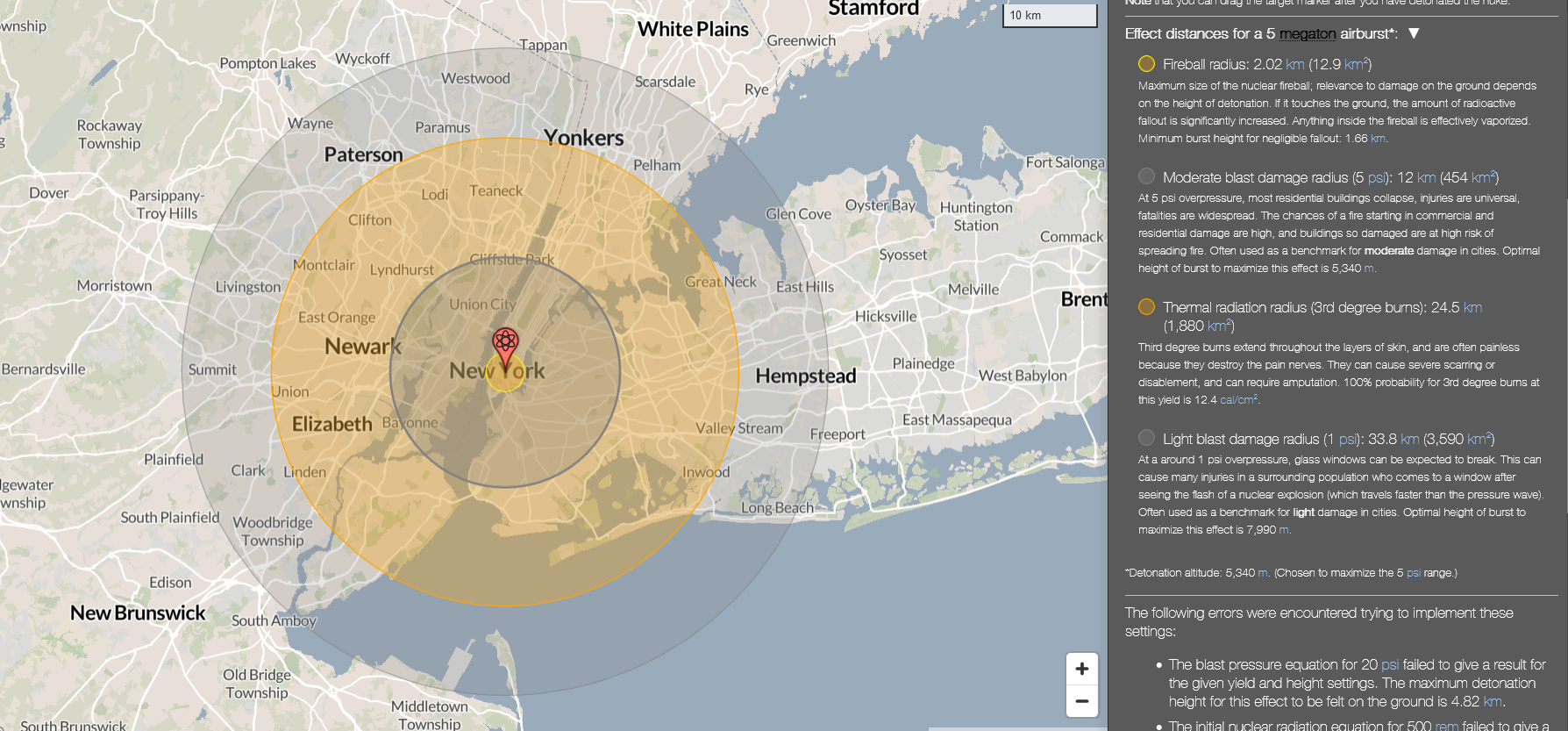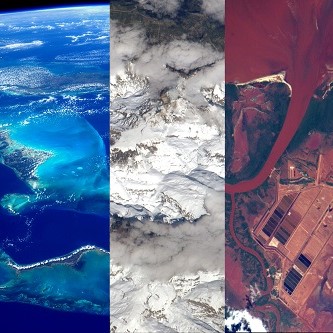I recently saw a comment chain about nuclear bombs, and that led me to thinking about this. Say there is a nuclear explosion in the downtown of my US city. I survive relatively fine, but obviously the main part of the city has been destroyed, while major zones extending from the center were also badly damaged. What would be a good response to (a) survive and (b) help out the recovery effort?
Probably just get away from the city or away from the radiation, forget about helping recovery effort as initial response. That can happen once your safe.
Assuming your home isn’t on fire. Seal everything, do not go outside! If possible, stay inside for as long as possible. Fill everything with water your bathtub, every cup, bucket, etc. Monitor the radio for emergency broadcasts for what to do next. AM stations are more likely to work. If you have a CB radio handy, (depending on your country) you can talk to authorities on Channel 9.
How long would I have to stay indoors? A week? A month?
Generally, the worst intensity stuff is actually over in the first 48-72 hours depending upon various factors. That’s not to say outside is completely safe after that (it wouldn’t be), but the level of danger is very different.
As long as possible to an indeterminate time and/or when authorities indicate to leave.
Tip regarding radio: 2182kHz near the coast. Those frequency is monitored by authorities globally. It’s the MF equivalent of maritime VHF ch16.
Source: I have a GOC
CB radio has really short range and there’s little likelihood that authorities would be monitoring it.
2182 kHz is long range marine radio and only good if you’re on a boat. I don’t know that anyone you talk to would care about a person on land while they’re handling their own maritime emergencies.
If someone really wants emergency radio I’d suggest ham radio or GMRS.
There is also amateur radio (aka ham radio), which can legally and practically operate at higher output powers if necessary, and on far more frequencies than CB. Although doomsday people often say to just buy a ham radio and use it without a license, I don’t advise that, simply because having the radio is only half the challenge.
The other half is the ability to competently operate the radio to effectively communicate and organize aid. And this only comes with practice, in the form of regular participation in radio nets and emcomm activities. Emergency radio isn’t even limited to voice transmissions, with digital modes and even fax modes being an option that can transmit quicker and farther.
While some people will make ham radio a lifelong hobby, others obtain their license simply for small-talk, or for a SHTF scenario, or as longer-distance walkie-talkies when camping in heavily wooded forests. The possibilities are endless, but it all starts with a first radio and some basic training on radio handling.
Ham radio clubs across the USA and the world are generally very welcoming of new folks, so it’s worth looking up your nearby club or drop in on an in-person club meeting.
The CB radio thing is going to be very location specific, I work in 911 dispatch, I think the state police around me theoretically monitor channel 9 on the highways, but in practice I wouldn’t have a lot of confidence in that, they barely look at info we send them over the computer, CB also has a somewhat limited range, so you’re counting on them having an officer somewhat nearby or you being close to their station.
As for local police, around me I suspect a few of them probably still have a CB antenna on the roof of their station and maybe even an old radio stashed somewhere in a closet but not hooked up and not being monitored, and the officers definitely don’t have them in their vehicles.
I’m in a pretty dense suburban area outside of a major city, they might still get some use in more rural areas where cell signals aren’t as reliable, though you’re probably going to run into the same issues with range limitations, in normal ideal conditions, you might get a range of about 20 miles or so, depending on atmospheric conditions, geography, etc. you might get only a fraction of that.
Thanks for the reminder, I have too look up where my designated bunker is.
KYAGB
“Kiss your ass goodbye” for those who left their Ovaltine decoder ring at home.
More like “KY (the jelly) Ass GameBoy”
That Kentucky Jelly tastes like shit and goes straight through you though. 6/10 at best.
I love lemmy. No one on r/drinks Ovaltine.
Good. Mo. Fo. Me.
Man I’ll probably die but I’m just gonna walk north. Idk. good as any other direction.
If you are exposed to particulate dust or debris, once you are inside an area that is enclosed, be mindful of everywhere you go and everything you touch, and consider them contaminated. The way radioactive contamination like dust participates are removed from people in places like nuclear power plants is with shaving cream. The way shaving cream expands on the skin lifts hair by design, but also lifts particulates so that they may be rinsed off.
The most dangerous radioactive elements have the shortest half lives. The quantity of particles is still important. Like the elephants foot at Chernobyl is still deadly to a human standing in the same room for only a few minutes due to quantity. However, just after a nuclear mass murder event by a subhuman psychopath, staying away from the earliest byproducts of the nuclear reaction is critical. These are extremely harmful even in the fine dust on the outskirts.
Nuclear technology is our most irresponsible atrocity we lack the time perspective to clearly understand. Imagine if the wars of the crusaders 1000 years ago were causing people to die directly as a result of their weapons, not because of geopolitical fallout. Nuclear is an atrocity for any use because of our incompetent governments, but it is a far greater crime on all future generations for thousands of years to come. History will make us the most despised humans in the entire lineage of the species. This is the only legacy any of us will be remembered for.
staying away from the earliest byproducts of the nuclear reaction is critical.
How would I know if something is a dangerous byproduct?
It’s there, near the blast zone. Everything will be irradiated. Everything.
People act like this will be survivable. It isn’t, not with current nuclear weapons. If the blast and shock wave don’t kill you, the radiation will. Or if you were lucky enough to be in a bunker, and you don’t have enough food and water, you will starve before it’s safe to leave.
The best case scenario is to die instantly in the blast. Second best is a bullet before your body literally falls apart from radiation poison.
Meaning anything that could fall from the sky or get blown around in the air. The particles themselves are heavier than lead, but ash can act like a parachute, and the massive explosion created enormous heat sending everything upwards into the higher layers of the atmosphere.
Any time you see a mushroom cloud, the expanding top stops when it hits a layer of atmosphere that is the same temperature as the rising column. This is true of volcanic eruptions and enormous bombs. The atmosphere gets colder with height, but only for a limited amount of time before the density is too low. Once the density is low enough with elevation, the temperature goes back up from solar radiation. When a plume is powerful enough to punch through the cold and back out into the hot on the other side, that is what can carry heavy particulates quite a long distance. There are winds across these layers that are different and the winds play a role in keeping the layers divided. Think of it like the way Jupiter looks with the cloud layers but in miniature scale that is not easy for human eyes to see. The entire Earth has a similar wind banding structure in the atmosphere. If you ever see wind diagrams for the southern hemisphere the effect is more clearly seen. The northern is a bit less banded due to continuous landmass heating, the Himalayas, and the shallowness of the Gulf of Mexico causing enormous evaporation with an impact stretching all the way into Europe.
The wind patterns carry the little parachutes with heavy radioactive junk and it settles like dust. So like, when we say sealed inside your home, that means duck tape on every door seal, and nothing that could pull air into or out of the space. The pro hazmat setup is a positive pressure bunker where there is a complex filter or recycled air scrubbing system that maintains a higher pressure inside the enclosure so that any leaks present force material out instead of in.
If the future remembers and hates us for nuclear… Good! Hopefully will they also remeber to be carefull and not dig where the waste gets buried
If a blast happens in your city and you live…it’s probably best to just suicide rather then deal with the literal fallout and radiation poisoning.
In Short, you will not survive…go painless
That was my first thought too, but i don’t know enough about blast radius to make a good decision. Are we talking 50 miles, 500 miles, …? Will it knock out a city, a state, or the country?
Depends on the yield of the bomb but if we use the current yield of chinese ICBMs and detonated it above NYC much of Long Island would be just erased and the rest would be leveled. Manhattan would probably just be a flat smoking wasteland.
https://nuclearsecrecy.com/nukemap/

On your map most of Long Island is unaffected. It’s 12km moderate blast damage (5 psi) from the Chinese nuke. Long Island goes way off to the east. It’s 190km long.
Tsar bomba is a different story though.
That map doesn’t look like it touch on the fallout at all, just the damage from the explosion.
Depending on how efficient the bomb is, and the direction of the winds, highly radioactive unspent fissile material will travel for miles. This stuff will shave decades off your life.
I checked the website out yesterday. You can either have the fallout shown or not. It also depends on whether you choose to detonate in the air or on the surface. But if you choose the option with the fallout, boy,… honestly maybe don’t because it was legit more depressing and scary than what you see in the screenshot above.
This is one of the fascinating things I learned about all the nuclear testing the USA was doing in the 70s 80s and 90s. They weren’t trying to make bigger bombs (that was 50s and 60s) it was making the same nuclear material in the bomb more completely used. The more of the material use, the less fallout.
For reference, the Hiroshima bomb used less than 2% of its fuel. Of its 64kg of uranium, only about 1kg actually split. The rest of the highly radioactive Uranium was just spread around by the explosion as fallout.
It’s 190km long.
Goddamn. I was thinking 50-75km tops.
There will be many warheads targeting the NYC area since it’s an economic hub. Most everything on that map will either be glass or on fire.
…unless the brain doesn’t die as fast as we believe, and so you become ‘paralyzed’ in a sense, beyond revival but still very aware of your predicament for some time. They do call it ‘practicing’ medicine, and nobody has been able to un-die and tell us what the actual process is.
Imagine it being like sleep paralysis, until you decompose. Decaying in a buried box is the ‘good’ way.
Things to think about.
I too read that SCP.
Go to the Winchester, have a nice cold pint, and wait for this all to blow over.
I love the background music playing during the Winchester scene…

Become a Brahmin rancher.
Say there is a nuclear explosion in the downtown of my US city.
If it’s that close you then essentially you’ll need to decide whether to die quick or slow :/
If you’re actually planning on surviving you’d need to stay in an underground bunker or something similar for at least 3-5 weeks to be safe enough to travel outside (and we’re assuming you have clean sources of food/water, bathroom, etc, during that time). If you make it that far then afterwards you’d likely want to go outside & get as far away from the radiation zone as possible.
Coincidentally the basement of my work building actually has a fallout shelter sign from back in the day so the basement might survive a blast but I don’t see how I’d make it 3-5 weeks without being extra prepared for that beforehand.
I’m far from an expert on this, but I would guess the safety of being outdoors heavily depends on additional factors, like for example wind direction and speed.
It really depends.
Scale of bomb
Design of bomb.
Distance from epicenter
Ground explosion or atmospheric
Prevailing winds
City construction
Etc, etc.
It’s nowhere near as simple as we’ve been taught.
I’ve looked at the bomb simulator linked above, and for me and my city, and where I live, prevailing winds, etc, only the two largest warheads would have direct effect on me, and fallout isn’t a concern for the rest (distance and prevailing winds).
Now after that, it would surely be a complete shit show. I’d likely have no water (or maybe I would, this suburb isnt tied to the city). Power would certainly be an issue, as would telephone/cell, radio would be problematic for a short while. Food would be a problem, of course.
I’ve looked at the bomb simulator linked above
I’m not seeing a link. Did it get deleted?
No time like the present to get involved with something like a Community Emergency Response Team or its local equivalent. FEMA has manuals and other training materials available online which address the matter of chemical, biological, radiological, nuclear and explosive (CBRNE; sometimes just CBRN or NBC depending on agency or publication date) incidents. Won’t make you an expert on yield estimation or fallout mapping but there is information which may be useful for improving individual and community resilience.
Personally, I think the likelihood of getting nuked is low and it’s much more likely that a CERT volunteer will be called upon to assist in natural disasters or major accidents to relieve the burden on professional crews. Where I live, teams have been employed to assist in redirecting traffic around areas with downed power lines or, in one case somewhat recently, a significant natural gas leak. Firefighters and other specialists establish a safe perimeter before handing off the site to volunteers so they can respond to other incidents throughout the city while repair crews work down their list of priorities.
Long comment short: building useful skills and relationships before shit meets fan means less scrambling to figure it out on that day and there are real, practical applications for that knowledge beyond LARPing with Jim-Bob’s moron militia.
Everybody is acting like its the apocalypse, just put on one off those N95 masks we all have from covid, get in your car and fuck off. Or walk, you can easily cover 30 miles in a few hours to the next not destroyed city.
People in this thread are playing way too much Fallout lol.
you can easily cover 30 miles in a few hours to the next not destroyed city.
Dude…how fast do you walk???
Sorry I meant kilometer, its like 19 miles. Which is doable in 6 - 8 hours.
In an irradiated wasteland.
Oh…yeah, I guess thats true. I was thinking you meant like 30 miles in 2-3 hours, which I won’t say is as fast as the flash…but maybe the flash’s infant baby?
Although, with me personally, I’d be like “uuuuggghhhhhh how long is this walking going to beeeee???”
And someone would say “we’ve been walking 45 minutes…so, maybe another 5 hours?”
“Ya know what? You guys go ahead without me. I’m just going to lay in the road and wait for the next bomb”
Pssshhhh!!! Walking…
A very fit athletic person who has done endurance training can do 30 miles in a day, but that’s not typical. Most people could do around 10+ if their life literally depended on it like in the aftermath of a nuke
Source: a brief web search
Yeah I meant kilometers.
If you survive (big if) find Steve Huffman, he thinks he’ll be a good leader in a post apocalyptic earth
Kurzgesagt has a video on it.
Excellent Video! And important call for nuclear disarmament.
The only time a nuke has ever been used in war was when only one country had them. Disarmament destroys MAD and makes it possible for only one country to have (and therefore use) nukes again.
have (and therefore use) nukes again
nukes, or anything else.
just look how great nuclear disarmament worked for ukraine. you can bet your right hand that no country will give their nukes up ever again.
I suspect you are at least as old as I am, from the MAD comment.
Why Mutually Assured Destruction Can No Longer Keep the World from Annihilation https://bigthink.com/politics-current-affairs/why-mutually-assured-destruction-can-no-longer-keep-the-world-from-annihilation/
Why MAD (Mutually Assured Destruction) Is No Longer Reassuring https://www.fdd.org/podcasts/2022/04/01/mutually-assured-destruction-no-longer-reassuring/
The Diminishing Reassurance Of Mutually-Assured Destruction https://theowp.org/reports/the-diminishing-reassurance-of-mutually-assured-destruction/
I live in Pentagon City VA, I’m not surviving shit. ☺
I’ll bet you an upvote that there’s several bunkers damn close to you. All you need to do is figure out who’ll let you use one.
I can guarantee that’s one of the cities in the US that has anti nuke defenses. The US has a tone of those. I haven’t checked but I also bet nobody is allowed to just randomly fly over the city or else they get shot down, and anybody who hijacks a passanger plane that does have clearance to fly over wouldn’t be able to smuggle a nuke onto it anyways.

















